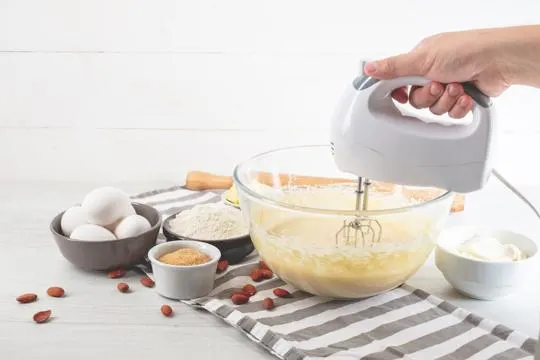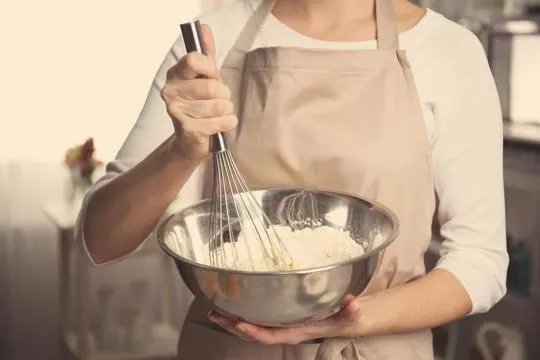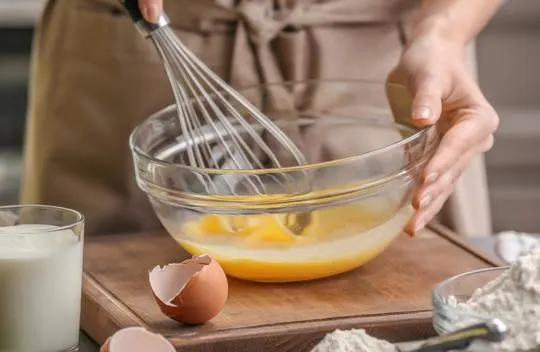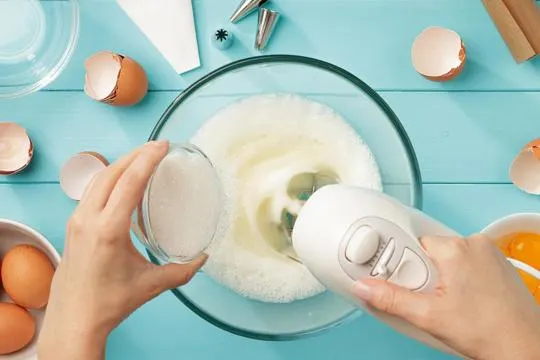In the kitchen, we’ve all faced the dilemma. Hand mixer or whisk?
These tools aren’t just utensils; they’re our partners in the crime of baking.
A hand mixer, with its electric power, makes us feel like wizards. Zap, and the batter’s smooth. On the other hand, the whisk gives us a workout. It’s us against the ingredients. And oh, the satisfaction of beating eggs to fluffy perfection with pure arm strength.
We’ve laughed over splattered walls and celebrated perfect peaks. Through trial and error, we’ve learned the value of each tool.
Short, sweet, and to the point. That’s how we roll.
What is a Hand Mixer?

A hand mixer is an essential kitchen appliance.
It’s versatile and compact, with easy-to-use functionality that both amateur and professional cooks love.
It has multiple speed settings, so you can adjust the intensity of the mixing to suit any recipe.
Start at a low speed and gradually increase.
This way you can prevent splattering or spilling.
The beaters rotate in opposite directions, creating a vortex that blends the ingredients together perfectly.
Attachments like dough hooks and whisks also come with some hand mixers.
These attachments let you mix heavier doughs and knead bread, as well as whip eggs or cream – making the mixer suitable for simple cakes to complex breads.
The hand mixer is ergonomic, with comfortable handles and a lightweight design.
It’s easy to maneuver and fits conveniently into small spaces.
In short, the hand mixer is a must-have tool in any kitchen.
It’ll make cooking simpler, and help you create delicious culinary masterpieces.
What is a Whisk?

A whisk is a must-have for any kitchen.
It has a handle with thin, flexible wires at one end.
This wire design helps mix liquids, incorporate air, and create a light texture.
Whisks come in different sizes and shapes, each suited for different tasks.
Beating eggs, whipping cream, mixing batters, and blending sauces – whisks do it all.
The wires ensure ingredients are blended and aerated perfectly.
Its versatility makes it great for both professional chefs and home cooks.
Differences Between Hand Mixer and Whisk

A hand mixer and a whisk may look similar, but they have their own unique features.
When choosing between a hand mixer or whisk, think about the outcome and recipe requirements.
Both tools can achieve effective mixing, but they offer different levels of convenience, control, and precision.
Design and Functionality
Hand mixers and whisks boast distinct designs and functions in the culinary world.
Hand mixers have powerful motors, allowing for faster and more efficient mixing.
They come with attachments like beaters and dough hooks, adding versatility to baking and cooking.
Whisks are simpler in design, featuring wire loops that incorporate air into ingredients.
This makes them great for whisking eggs, cream, and delicate batters.
Plus, they’re easier to clean and store.
Hand mixers normally have multiple speed settings, letting users control the blending according to their needs.
Whisks, however, rely solely on manual control and technique.
Plus, hand mixers give you extra features like a rotating bowl stand or built-in timer, enhancing convenience and precision during mixing.
Efficiency and Speed
Comparing a hand mixer to a whisk, efficiency and speed are key.
Both offer unique advantages for cooking.
The hand mixer leads in efficiency, with its electric motor-powered beaters.
It whips together ingredients quickly, making a lighter, fluffier texture.
The whisk is not as fast, but offers better control.
Its gentle motion allows precise blending without overworking.
Plus, it’s more versatile.
Cleanup and storage are easier, and small batches can be handled effectively.
Versatility and Applications
Hand mixers and whisks stand out in the kitchen.
Each one has its own special use.
Hand mixers are a powerhouse.
They can whip cream, knead dough, and more.
Adjustable speed settings let you control what you make.
Attachments like beaters and dough hooks let you cook different recipes.
Whether making cookies or cake batter, hand mixers come in handy.
Whisks are simple, yet versatile.
They use wire loops to mix ingredients.
They can blend liquids, emulsify dressings, and create sauces.
Lightweight design allows for whisking without tiring out your arm.
Plus, whisks can make mixtures airy.
Hand mixers offer power and efficiency.
But, sometimes it’s best to use a whisk for delicate preparations.
They’re perfect for small quantities and frothing milk or making vinaigrette.
Ease of Use and Convenience
What to use: a hand mixer or a whisk? It depends on the task.
Both can be great, but each has its strengths.
A hand mixer is speedy and efficient.
It has a powerful motor and lots of attachments.
Plus, its ergonomic design means less hand and arm strain.
A whisk gives precision and versatility.
Its wire loops can stir and fold gently.
This makes whisking egg whites super easy.
Plus, whisking can be very calming.
Sometimes recipes call for both tools.
For example, start with a hand mixer to mix quickly, then switch to a whisk for more precise work.
It comes down to personal preference and what the recipe needs.
Both tools have a place in the kitchen.
So when baking cookies or making meringue, pick the tool that best suits ease of use and convenience.
Similarities Between Hand Mixer and Whisk

The hand mixer and whisk have many similarities that make them must-have kitchen tools.
Both are used to blend ingredients, for baking or cooking.
But, there are distinct details that set them apart.
The hand mixer and whisk give convenience in the kitchen.
The hand mixer is electric, with rotating beaters.
This makes it swift and effective.
The whisk needs manual movement to create a swirling action and incorporate air.
This makes a light and fluffy mixture.
Sometimes, one tool is better than the other.
The whisk is great for beating eggs or liquids, combining them without overmixing.
This is good for delicate recipes or precision.
The hand mixer is perfect for heavier doughs or batters.
It saves time and makes a smooth texture with even flavor distribution.
When to Use a Hand Mixer and When to Use a Whisk
A hand mixer and a whisk are must-haves in the kitchen.
But, which to use when? A hand mixer is great for tasks needing lots of beating and mixing.
Its fast speeds and attachments make it easy to make airy results.
Whereas, a whisk is perfect for gentle blending and incorporating air.
An ideal tool for eggs, dry ingredients, and sauces.
Baking cakes, cookies, or other desserts? Hand mixer to the rescue.
Its powerful motor and attachments make it perfect for creaming butter and sugar, or beating egg whites.
With a hand mixer, you’ll get consistent mixing and perfect results.
But, when you need delicate results, try a whisk.
It’s great for folding in ingredients, making meringues or soufflés.
Also, it’s perfect for emulsifying dressings or creating light and airy sauces without overmixing.
The whisk’s ability to aerate liquids and combine ingredients delicately proves its worth.
Cleaning and Maintenance Tips for Hand Mixers and Whisks
To ensure your hand mixer and whisk last and perform optimally, use these tips.
- Soapy warm water: After each use, wash the beaters or whisk with soapy water. Check for stuck-on batter/dough.
- Cords: Unplug before cleaning. Use a damp cloth to remove spills/stains. Don’t submerge cords in water.
- Body: Wipe the body with a damp cloth. Be gentle around buttons/switches.
- Removing attachments: Hold firmly and pull straight out. No twisting/jerking.
- Dry: After washing, dry all parts completely before storing. Moisture can cause rust/damage.
- Store safely: Find a dry spot. Avoid humid areas, sunlight, and extreme temperatures.
Check regularly for any signs of wear/damage.
If you notice frayed cords/loose parts, stop using and get inspected by a professional.
Proper care = better performance.
Follow these tips to keep your hand mixer and whisk in great condition.
Conclusion
Hand mixers and whisks are both great kitchen tools.
Hand mixers offer power and speed for heavier tasks.
Whisks are perfect for incorporating air and creating light, fluffy textures.
Both are convenient. Hand mixers are compact and easy to store.
Whisks take up minimal space and can be easily cleaned.
Choose between the two depending on the task and your cooking style.
Harness their unique capabilities to make your culinary creations amazing.

Leave a comment